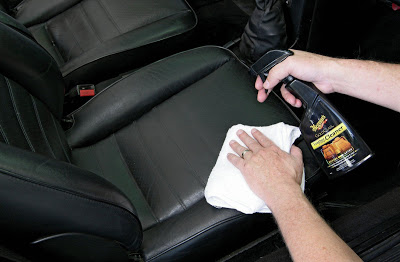 Leather seats have been part of many cars for nearly over a hundred years. They are attractive to look at and very comfortable to sit in. The main advantage of leather is that when there’s hot weather, the seats absorb perspiration whereas vinyl seats trap the perspiration and get sticky. Plus there is nothing like the smell of a leather seats in a car.
Leather seats have been part of many cars for nearly over a hundred years. They are attractive to look at and very comfortable to sit in. The main advantage of leather is that when there’s hot weather, the seats absorb perspiration whereas vinyl seats trap the perspiration and get sticky. Plus there is nothing like the smell of a leather seats in a car.
But, leather requires maintenance, certainly more than vinyl seats. Because leather is organic, it can deteriorate over time because it loses natural oils. As a result, it is recommended you clean and condition your car’s leather seats freque
ntly. Here is a short guide on how to do it:
Cleaning
You can best clean leather by using a quality, specifically designed leather cleaner. There are many cleaners that exist and they are designed to gently re-hydrate whatever grime and gunk accumulate on the seating. After these products rehydrate the grime, the leather should be cleaned off. Use only leather products on leather, rather than vinyl or all-purpose cleaners, as these products are much too harsh for leather.
The general procedure for leather cleaners is easy: Apply a small amount of your chosen cleaner to a wet cloth and lather up all your leather surfaces. After sitting for a few minutes, remove the excess lather then provide the leather with a good cleaning with clean water and a sponge. After this remove residual moisture with a towel and allow all the leather surfaces to dry for an hour or so.
Conditioning
Once your leather is cleaned up, you should certainly restore lost oils with a quality leather conditioner. Ensure that this conditioner is water based and a PH neutral one that is of high quality. Luckily, using a leather conditioner is simple.
Here’s what to do: put a little bit of the conditioner of it on an applicator pad or cotton cloth and rub gently onto the surface. Do not be afraid to really saturate the leather. Then allow it to absorb for several minutes–it may even be a good idea to park the car in the shade or in the garage overnight so UV light does not interfere with the absorption- and then wipe off the excess. Don’t over-condition your seats, though; the majority of seats require conditioning only a couple of times a year.
Neglected Leather
The majority of people don’t treat their leather enough. This is why you see so many older cars with stiff leather seats. If your leather hardened or needs a good deal of softening, there are several products available to help you with this. The products are paste-like and are designed to really penetrate into the leather surface. You usually coat the old leather surfaces with a great thick coat of the product and let it sink in for 24 hours or so. Depending upon the condition of the leather, the seats may require numerous additional applications too. With luck, you should pull through with resurrecting the old leather you started with and have softer, more appealing surfaces to use.
Article Courtesy of: Thompson Chrysler

